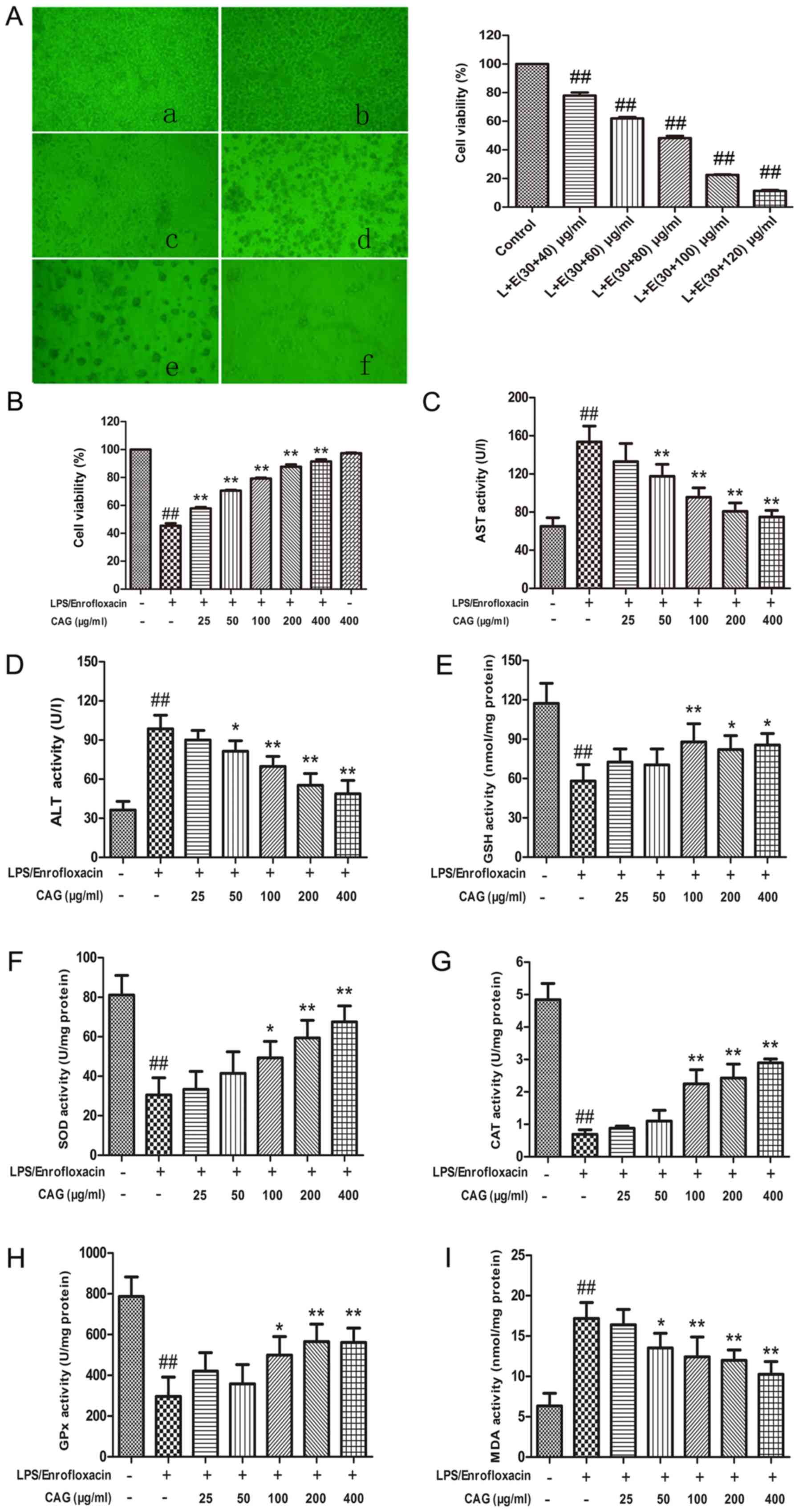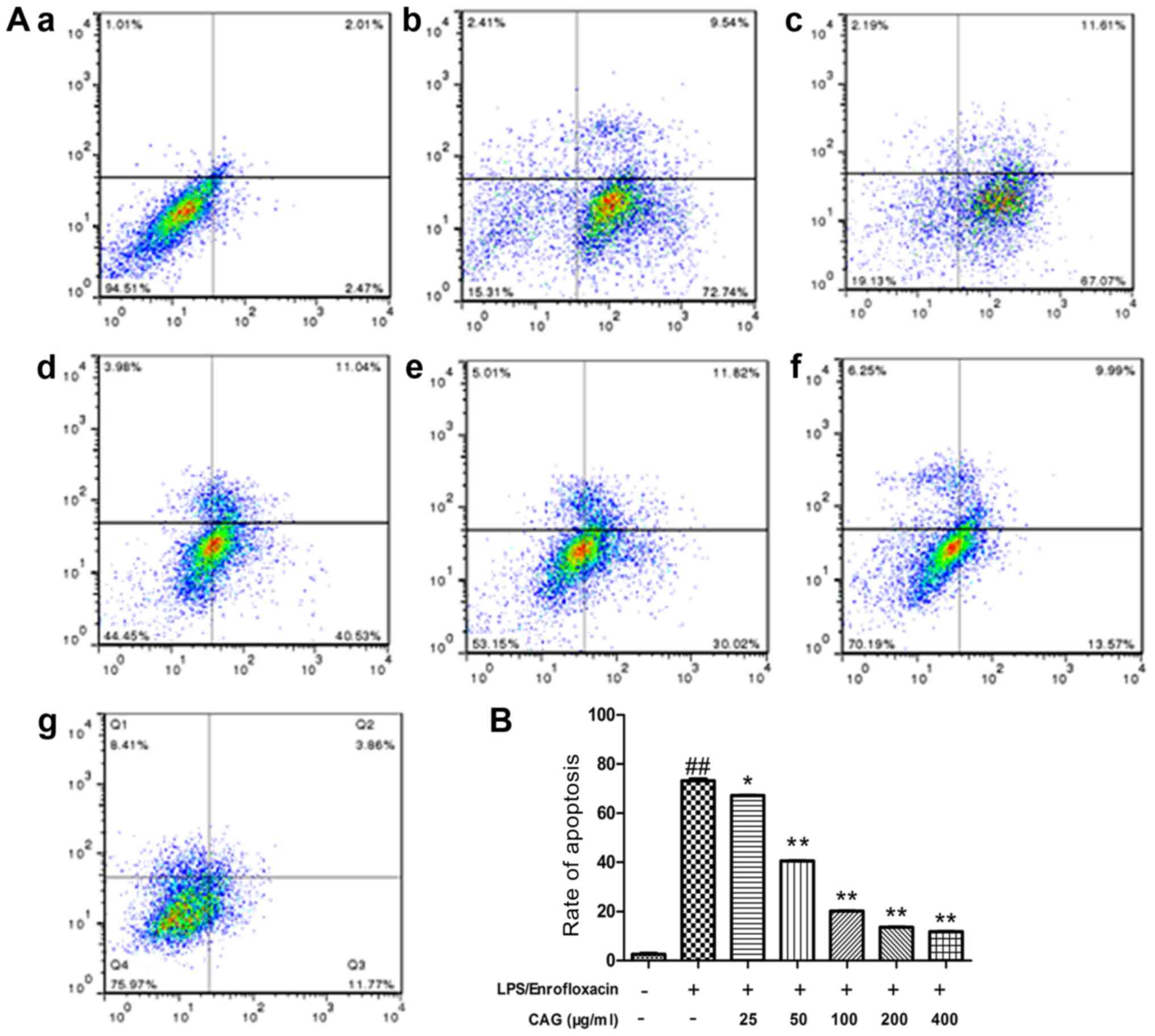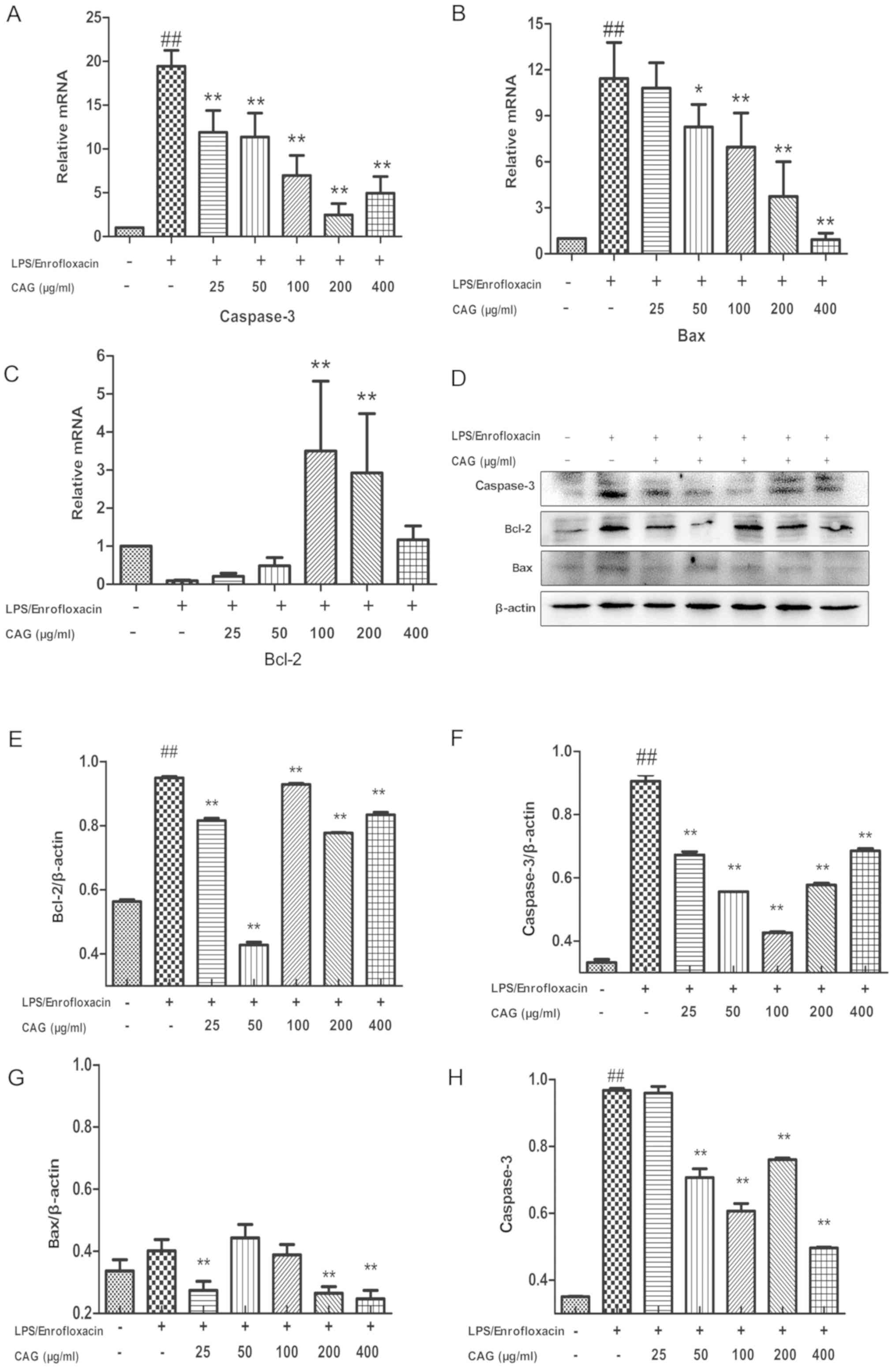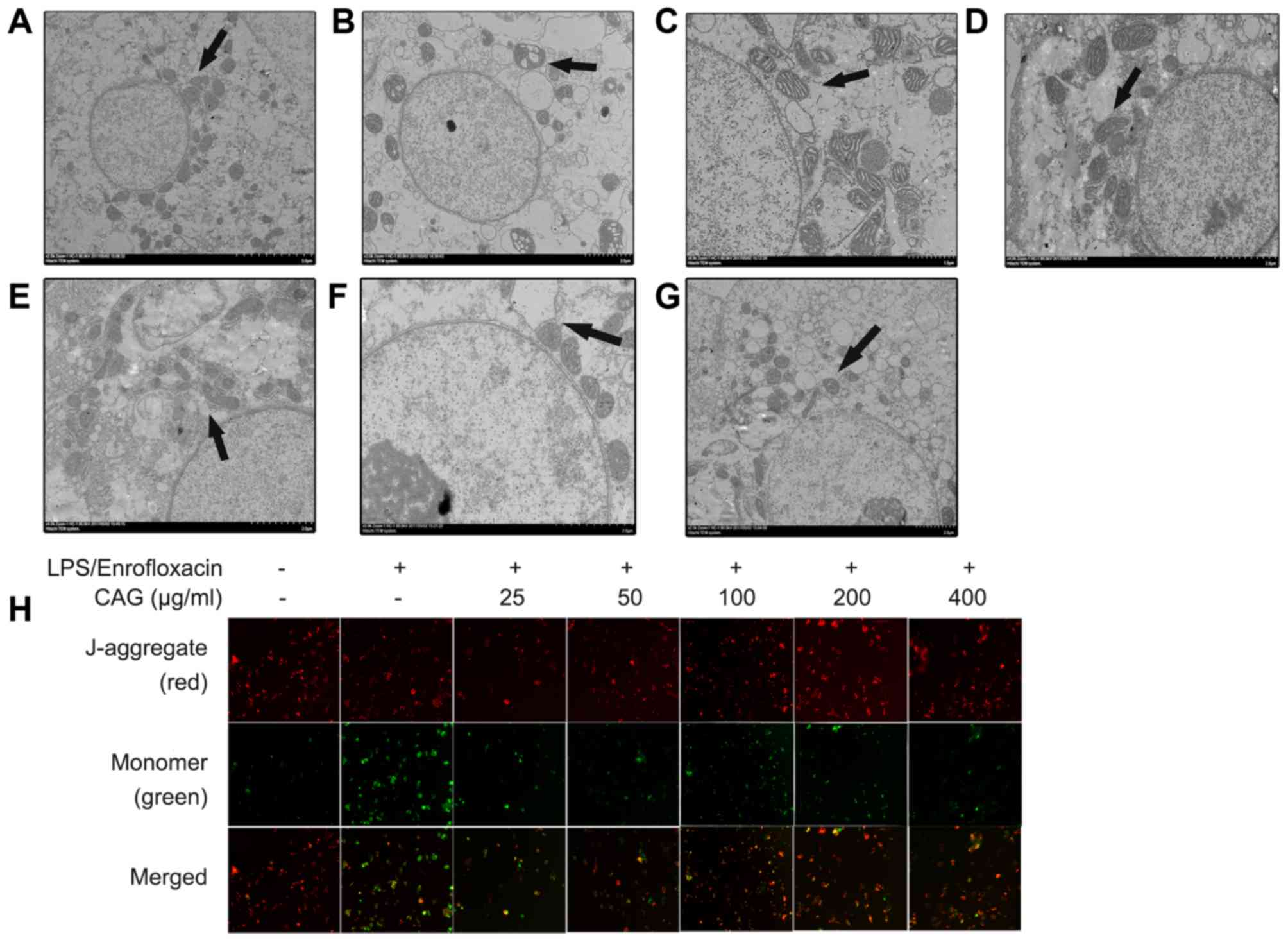|
1
|
Xia X, Su C, Fu J, Zhang P, Jiang X, Xu D,
Hu L, Song E and Song Y: Role of α-lipoic acid in LPS/d-GalN
induced fulminant hepatic failure in mice: Studies on oxidative
stress, inflammation and apoptosis. Int Immunopharmacol.
22:293–302. 2014.PubMed/NCBI View Article : Google Scholar
|
|
2
|
Jeong YI, Jung ID, Lee CM, Chang JH, Chun
SH, Noh KT, Jeong SK, Shin YK, Lee WS, Kang MS, et al: The novel
role of platelet-activating factor in protecting mice against
lipopolysaccharide-induced endotoxic shock. PLoS One.
4(e6503)2009.PubMed/NCBI View Article : Google Scholar
|
|
3
|
Thirunavukkarasu C, Uemura T, Wang LF,
Watkins SC and Gandhi CR: Normal rat hepatic stellate cells respond
to endotoxin in LBP-independent manner to produce inhibitor(s) of
DNA synthesis in hepatocytes. J Cell Physiol. 204:654–665.
2005.PubMed/NCBI View Article : Google Scholar
|
|
4
|
Kaplowitz N: Drug-induced liver disorders:
Implications for drug development and regulation. Drug Saf.
24:483–490. 2001.PubMed/NCBI View Article : Google Scholar
|
|
5
|
Hirashima R, Itoh T, Tukey RH and Fujiwara
R: Prediction of drug-induced liver injury using keratinocytes. J
Appl Toxicol. 37:863–872. 2017.PubMed/NCBI View
Article : Google Scholar
|
|
6
|
Ghabril M, Chalasani N and Bjornsson E:
Drug-induced liver injury: A clinical update. Curr Opin
Gastroenterol. 26:222–226. 2010.PubMed/NCBI View Article : Google Scholar
|
|
7
|
Leitner JM, Graninger W and Thalhammer F:
Hepatotoxicity of antibacterials: Pathomechanisms and clinical.
Infection. 38:3–11. 2010.PubMed/NCBI View Article : Google Scholar
|
|
8
|
Yilmaz B, Ekiz F, Coban S, Yüksel I and
Yüksel O: Cefixime-induced hepatotoxicity. Turk J Gastroenterol.
22(445)2011.PubMed/NCBI View Article : Google Scholar
|
|
9
|
Orman ES, Conjeevaram HS, Vuppalanchi R,
Freston JW, Rochon J, Kleiner DE and Hayashi PH: DILIN Research
Group: Clinical and histopathologic features of
fluoroquinolone-induced liver injury. Clin Gastroenterol Hepatol.
9:517–523 e3. 2011.PubMed/NCBI View Article : Google Scholar
|
|
10
|
Liu B, Cui Y, Brown PB, Ge X, Xie J and Xu
P: Cytotoxic effects and apoptosis induction of enrofloxacin in
hepatic cell line of grass carp (Ctenopharyngodon idellus). Fish
Shellfish Immunol. 47:639–644. 2015.PubMed/NCBI View Article : Google Scholar
|
|
11
|
Kalpana S, Aggarwal M, Srinivasa Rao G and
Malik JK: Effects of aflatoxin B1 on tissue residues of
enrofloxacin and its metabolite ciprofloxacin in broiler chickens.
Environ Toxicol Pharmacol. 33:121–126. 2012.PubMed/NCBI View Article : Google Scholar
|
|
12
|
Shinozuka Y, Uematsu K, Takagi M and Taura
Y: Comparison of the amounts of endotoxin released from Escherichia
coli after exposure to antibiotics and ozone: An in vitro
evaluation. J Vet Med Sci. 70:419–422. 2008.PubMed/NCBI View Article : Google Scholar
|
|
13
|
Oh HM, Lee S, Park YN, Choi EJ, Choi JY,
Kim JA, Kweon JH, Han WC, Choi SC, Han JK, et al: Ammonium
glycyrrhizinate protects gastric epithelial cells from hydrogen
peroxide-induced cell death. Exp Biol Med (Maywood). 234:263–277.
2009.PubMed/NCBI View Article : Google Scholar
|
|
14
|
Sato H, Goto W, Yamamura J, Kurokawa M,
Kageyama S, Takahara T, Watanabe A and Shiraki K: Therapeutic basis
of glycyrrhizin on chronic hepatitis B. Antiviral Res. 30:171–177.
1996.PubMed/NCBI View Article : Google Scholar
|
|
15
|
Yamamura Y, Kotaki H, Tanaka N, Aikawa T,
Sawada Y and Iga T: The pharmacokinetics of glycyrrhizin and its
restorative effect on hepatic function in patients with chronic
hepatitis and in chronically carbon-tetrachloride-intoxicated rats.
Biopharm Drug Dispos. 18:717–725. 1997.PubMed/NCBI View Article : Google Scholar
|
|
16
|
Lin JC, Cherng JM, Hung MS, Baltina LA,
Baltina L and Kondratenko R: Inhibitory effects of some derivatives
of glycyrrhizic acid against Epstein-Barr virus infection:
Structure-activity relationships. Antiviral Res. 79:6–11.
2008.PubMed/NCBI View Article : Google Scholar
|
|
17
|
Fiore C, Eisenhut M, Krausse R, Ragazzi E,
Pellati D, Armanini D and Bielenberg J: Antiviral effects of
glycyrrhiza species. Phytother Res. 22:141–148. 2008.PubMed/NCBI View
Article : Google Scholar
|
|
18
|
Seeff LB, Lindsay KL, Bacon BR, Kresina TF
and Hoofnagle JH: Complementary and alternative medicine in chronic
liver disease. Hepatology. 34:595–603. 2001.PubMed/NCBI View Article : Google Scholar
|
|
19
|
Stickel F and Schuppan D: Herbal medicine
in the treatment of liver diseases. Dig Liver Dis. 39:293–304.
2007.PubMed/NCBI View Article : Google Scholar
|
|
20
|
Visavadiya NP and Narasimhacharya AV:
Hypocholesterolaemic and antioxidant effects of glycyrrhiza glabra
(Linn) in rats. Mol Nutr Food Res. 50:1080–1086. 2006.PubMed/NCBI View Article : Google Scholar
|
|
21
|
Racková L, Jancinová V, Petríková M,
Drábiková K, Nosál R, Stefek M, Kostálová D, Prónayová N and
Kovácová M: Mechanism of anti-inflammatory action of liquorice
extract and glycyrrhizin. Nat Prod Res. 21:1234–1241.
2007.PubMed/NCBI View Article : Google Scholar
|
|
22
|
Yim SB, Park SE and Lee CS: Protective
effect of glycyrrhizin on 1-methyl-4-phenylpyridinium-induced
mitochondrial damage and cell death in differentiated PC12 cells. J
Pharmacol Exp Ther. 321:816–822. 2007.PubMed/NCBI View Article : Google Scholar
|
|
23
|
LaBrecque DR and Howard RB: The
preparation and characterization of intact isolated parenchymal
cells from rat liver. Methods Cell Biol. 14:327–340.
1976.PubMed/NCBI View Article : Google Scholar
|
|
24
|
Morikawa A, Sugiyama T, Kato Y, Koide N,
Jiang GZ, Takahashi K, Tamada Y and Yokochi T: Apoptotic cell death
in the response of D-galactosamine-sensitized mice to
lipopolysaccharide as an experimental endotoxic shock model. Infect
Immun. 64:734–738. 1996.PubMed/NCBI View Article : Google Scholar
|
|
25
|
Livak KJ and Schmittgen TD: Analysis of
relative gene expression data using real-time quantitative PCR and
the 2(-Delta Delta C(T)) method. Methods. 25:402–408.
2001.PubMed/NCBI View Article : Google Scholar
|
|
26
|
Shiota M, Sugai N, Tamura M, Yamaguchi R,
Fukushima N, Miyano T and Miyazaki H: Correlation of
mitogen-activated protein kinase activities with cell survival and
apoptosis in porcine granulosa cells. Zoolog Sci. 20:193–201.
2003.PubMed/NCBI View Article : Google Scholar
|
|
27
|
Szeto HH: Mitochondria-targeted peptide
antioxidants: Novel neuroprotective agents. AAPS J. 8:E521–E531.
2006.PubMed/NCBI View Article : Google Scholar
|
|
28
|
Lowry OH, Rosebrough NJ, Farr AL and
Randall RJ: Protein measurement with the Folin phenol reagent. J
Biol Chem. 193:265–275. 1951.PubMed/NCBI
|
|
29
|
Mohammadi M and Yazdanparast R: Methoxy
VO-salen complex: In vitro antioxidant activity, cytotoxicity
evaluation and protective effect on CCl4-induced oxidative stress
in rats. Food Chem Toxicol. 47:716–721. 2009.PubMed/NCBI View Article : Google Scholar
|
|
30
|
Song E, Fu J, Xia X, Su C and Song Y:
Bazhen decoction protects against acetaminophen induced acute liver
injury by inhibiting oxidative stress, inflammation and apoptosis
in mice. PLoS One. 9(e107405)2014.PubMed/NCBI View Article : Google Scholar
|
|
31
|
Srivastava M, Ma LQ, Singh N and Singh S:
Antioxidant responses of hyper-accumulator and sensitive fern
species to arsenic. J Exp Bot. 56:1335–1342. 2005.PubMed/NCBI View Article : Google Scholar
|
|
32
|
Shamsabadi FT, Eidgahi MR, Mehrbod P,
Daneshvar N, Allaudin ZN, Yamchi A and Shahbazi M: Survivin, a
promising gene for targeted cancer treatment. Asian Pac J Cancer
Prev. 17:3711–3719. 2016.PubMed/NCBI
|
|
33
|
Danial NN and Korsmeyer SJ: Cell death:
Critical control points. Cell. 116:205–219. 2004.PubMed/NCBI View Article : Google Scholar
|
|
34
|
Jaeschke H, Gujral JS and Bajt ML:
Apoptosis and necrosis in liver disease. Liver Int. 24:85–89.
2004.PubMed/NCBI View Article : Google Scholar
|
|
35
|
Kasahara I, Saitoh K and Nakamura K:
Apoptosis in acute hepatic failure: Histopathological study of
human liver tissue using the tunel method and immunohistochemistry.
J Med Dent Sci. 47:167–175. 2000.PubMed/NCBI
|
|
36
|
Eichhorst ST: Modulation of apoptosis as a
target for liver disease. Expert Opin Ther Targets. 9:83–99.
2005.PubMed/NCBI View Article : Google Scholar
|
|
37
|
Togo S, Kubota T, Matsuo K, Shimizu T,
Momiyama N, Takeda K, Tanaka K, Endo I, Sekido H and Shimada H:
Mechanism of liver failure after hepatectomy. Nihon Geka Gakkai
Zasshi. 105:658–663. 2004.(In Japanese). PubMed/NCBI
|
|
38
|
Liu LM, Zhang JX, Luo J, Guo HX, Deng H,
Chen JY and Sun SL: A role of cell apoptosis in lipopolysaccharide
(LPS)-induced nonlethal liver injury in D-galactosamine
(D-GalN)-sensitized rats. Dig Dis Sci. 53:1316–1324.
2008.PubMed/NCBI View Article : Google Scholar
|
|
39
|
Wang XJ, Kong KM, Qi WL, Ye WL and Song
PS: Interleukin-1 beta induction of neuron apoptosis depends on p38
mitogen-activated protein kinase activity after spinal cord injury.
Acta Pharmacol Sin. 26:934–942. 2005.PubMed/NCBI View Article : Google Scholar
|
|
40
|
Guo XL, Liang B, Wang XW, Fan FG, Jin J,
Lan R, Yang JH, Wang XC, Jin L and Cao Q: Glycyrrhizic acid
attenuates CCl4-induced hepatocyte apoptosis in rats via
a p53-mediated pathway. World J Gastroenterol. 19:3781–3791.
2013.PubMed/NCBI View Article : Google Scholar
|
|
41
|
Chen XC, Zhu YG, Wang XZ, Zhu LA and Huang
C: Protective effect of ginsenoside Rg1 on dopamine-induced
apoptosis in PC12 cells. Acta Pharmacol Sin. 22:673–678.
2001.PubMed/NCBI
|
|
42
|
Porter AG and Jänicke RU: Emerging roles
of caspase-3 in apoptosis. Cell Death Differ. 6:99–104.
1999.PubMed/NCBI View Article : Google Scholar
|
|
43
|
Wolter KG, Hsu YT, Smith CL, Nechushtan A,
Xi XG and Youle RJ: Movement of Bax from the cytosol to
mitochondria during apoptosis. J Cell Biol. 139:1281–1292.
1997.PubMed/NCBI View Article : Google Scholar
|


















